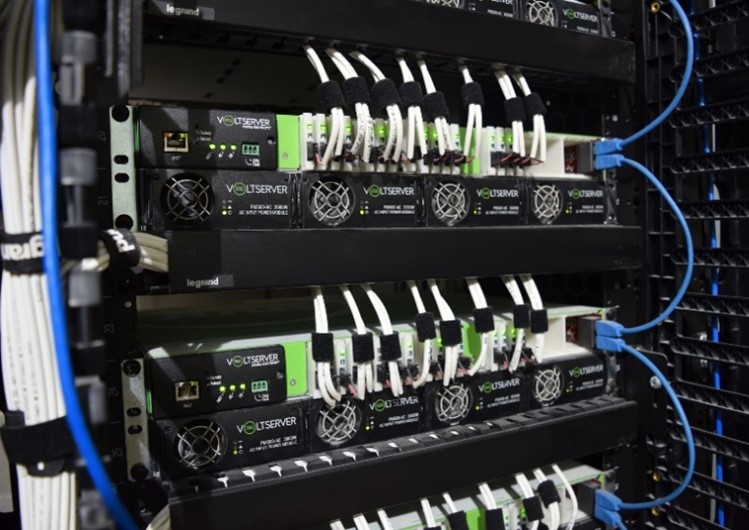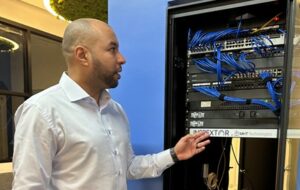How Cutting-edge Technology is Revolutionizing Energy Management, Automation, and Sustainability in Smart Buildings
by Ric Sepulveda, CCNA R/S & Security, MCP, Senior Associate
Disruptive technologies have the power to fundamentally change the way we live, work, and interact with the world around us. They challenge the status quo, driving innovation and paving the way for new opportunities and growth. Universal Power over Ethernet (UPoE) and Internet of Things (IoT) technology, two such disruptive forces, are rapidly transforming building automation and sustainability. By connecting devices, systems, and people in ways that were previously unimaginable, these technologies enable the creation of intelligent, green, and connected facilities that redefine the concept of smart buildings.
In a world where sustainability and energy efficiency have taken center stage, smart building technology is rapidly evolving to meet these demands. Among the trends that are revolutionizing building automation are Universal Power over Ethernet (UPoE) and Internet of Things (IoT) technology. These innovations are being integrated into building automation systems, resulting in intelligent, green, and connected structures.
UPoE(+), a technology that delivers up to 90 watts of power over Ethernet cables, has emerged as a catalyst for IoT integration in smart buildings. With UPoE, devices can be powered and network connected simultaneously, eliminating the need for separate power cables and simplifying the deployment of IoT devices. This enables seamless fusion of building automation systems like lighting, HVAC, security, and others, resulting in real-time control and monitoring of energy usage.
The IoT revolution allows smart buildings to collect and analyze vast amounts of data from various sensors and devices allowing building managers to make intelligent, data-driven decisions to optimize energy consumption, reduce operational costs, and enhance the overall experience for occupants.
MHT Lighting’s InspeXtor: A Leading Solution in a Growing Market
One example of this integration is InspeXtor, a Power over Ethernet (PoE) solution by MHT Lighting. According to the company, “InspeXtor is a game changer for smart buildings, as it provides a seamless integration of lighting and building automation systems, enabling real-time control and monitoring of energy usage, while delivering optimal lighting conditions for building occupants.” MHT Lighting is a great example in a growing group of companies providing solutions for facility managers to monitor and control various aspects of their building, including lighting, temperature, and security, through a single, user-friendly interface.
The Sinclair Hotel in Fort Worth, Texas, serves as a prime example of how UPoE and IoT technologies can come together to create a truly smart building. This historic hotel has been retrofitted with state-of-the-art technology, making it one of the most technologically advanced and energy-efficient hotels in the world.
Utilizing UPoE to power its IoT devices, the Sinclair Hotel has successfully integrated lighting, HVAC, and security systems, resulting in the potential for significant energy savings and an enhanced guest experience. The following factors contribute to the potential reduction in energy consumption:
LED Smart Lighting: Using energy-efficient LED lights paired with ambient light sensors and centrally programmed templates, provides significantly less consumption of energy. Remarkably, UPoE lights in an idle-off state pull 1/10th the power of traditional lighting.
Automated Lighting Control: Occupancy sensors and daylight harvesting systems ensure that lights are only on when necessary, which can greatly decrease energy consumption.
HVAC Optimization: The implementation of IoT-enabled HVAC systems allows for precise temperature control and better energy management. By automatically adjusting the temperature based on occupancy and environmental factors, the hotel can save energy and reduce costs.
Predictive Maintenance: IoT technology enables the monitoring of equipment performance, allowing for predictive maintenance and timely replacements. This ensures that all systems are operating at peak efficiency to reduce energy waste.
With these measures in place, the Sinclair Hotel has the potential to achieve significant energy savings, further demonstrating the effectiveness of UPoE and IoT technology in creating greener, more sustainable, and intelligent buildings for the future.
Beyond UPoE & IoT Technologies: While Universal Power over Ethernet (UPoE) and Internet of Things (IoT) technology have proven to be game changers in building automation and sustainability, they are not the only disruptive forces shaping the world today. Various cutting-edge technologies are working in tandem to revolutionize industries, improve efficiency, and create more sustainable living and working spaces. The following technologies are making a significant impact in today’s world and are important complements to advancements in building automation.
Artificial Intelligence (AI) and Machine Learning: AI and machine learning have been making waves across various industries, including building automation. These technologies are key to analyzing the vast amounts of data collected by IoT devices, enabling smart buildings to identify patterns and make data-driven decisions to optimize energy consumption, security, and comfort. By using AI-powered algorithms, building managers can uncover new ways to improve efficiency and reduce operational costs while providing a better experience for occupants.
Blockchain Technology: This decentralized and secure digital ledger system has the potential to enhance building automation by providing a transparent and tamper-proof record of energy consumption, maintenance, and other building-related transactions. Blockchain can also streamline the process of energy trading between smart buildings and utility companies, enabling more efficient and transparent energy markets overall.
Energy Storage and Renewable Energy: Advancements in energy storage technologies, such as batteries and thermal storage, are playing a crucial role in promoting the adoption of renewable energy sources like solar and wind power. These storage solutions can be integrated with building automation systems, allowing buildings to store excess energy produced during peak generation periods and use it during periods of high demand or low generation. This not only reduces the reliance on traditional energy sources but also lowers the overall carbon footprint of the building.
Augmented Reality (AR) and Virtual Reality (VR): AR and VR technologies are transforming the way we design, build, and maintain smart buildings. Architects and engineers can use these immersive technologies to visualize and test building designs before construction, while maintenance teams can use AR to access real-time information about equipment and systems to streamline the repair process. Additionally, AR and VR can enhance occupant experiences by enabling interactive and immersive building features.
The future of building automation is an exhilarating frontier, where the convergence of UPoE, IoT, and other disruptive technologies will enable us to create spaces that seamlessly blend with our lives by adapting and evolving to meet our ever-changing needs. As we embrace these incredible technologies, we step into a future where buildings are not just structures, but responsive and adaptive entities that empower us to be more connected with each other, more sustainable, and more in tune with the world around us.

